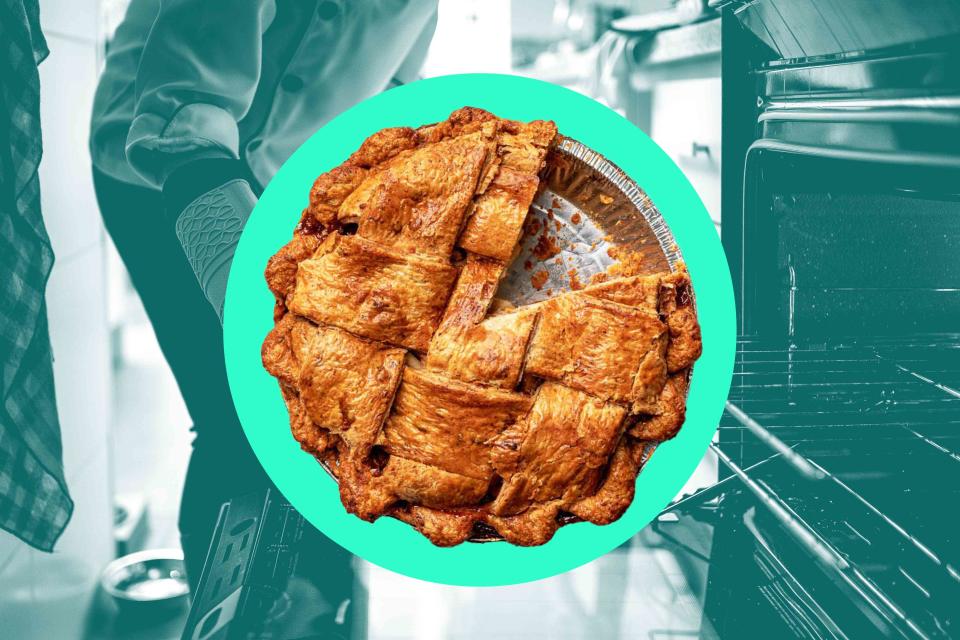Why You Should Bake Your Pie for Longer Than You Think
Read this before taking your fruit pie out of the oven.

FOOD & WINE / GERARD + BELEVENDER / GETTY IMAGES
I come from a family of pie people. At a celebration of life for my late Grandpa Dave, my mom delivered a speech that centered around her dad’s love of the iconic pastry — and really, what is more celebratory or life-affirming than pie?
I learned that Grandpa Dave’s love of pie started with his own mother, who would task him with collecting blueberries each summer for the ultimate reward of fresh blueberry pie. Maybe that’s why he showed a proclivity toward fruit pies, especially apple. When, upon meeting my grandpa, my dad admitted he wasn’t a big fan of apple pie, Grandpa Dave famously said to my mom, “I don’t know about this guy.”
"Dry cake is irredeemable. Burnt cookies? Inedible! But it turns out that a pie, particularly a fruit-filled one, is very hard to overbake."
This is all to say, pie is in my blood — and I thought I knew quite a bit about making a good one. As I dutifully rolled out pie dough for any gathering, I learned to rely on my instincts, adding a little more ice water to hold it together or flour when things got sticky. But as I started following bakers like Erin Jeannne McDowell on Instagram and admiring their burnished brown creations, I realized I was making a hands-off mistake. I was underbaking my pies.
According to our test kitchen, this is a common mistake. More people underbake than overbake pies, and it makes sense that bakers like myself would be fearful of leaving pie in the oven for too long. Generally speaking, overbaking desserts does not yield delicious results. Dry cake is irredeemable. Burnt cookies? Inedible! But it turns out that a pie, particularly a fruit-filled one, is very hard to overbake.
Related: 15 Beautiful Pies to Make This Summer
How do you know when a fruit pie is done baking?
Recipes typically call for baking fruit pies at a high temperature, about 425°F, then reducing the heat and baking for an additional one to two hours. Why the wide time range? “Visual indicators are more important than cook times,” explains F&W food editor and resident baking expert Paige Grandjean.
“Deep golden brown crusts have the best buttery, toasty flavor,” she adds. “Pale, blonde crusts are typically less flaky and oftentimes have a raw flour taste.”
So, other than a deeply browned color, what other visual indicators can you look for? “You can tell a fruit pie is done when the juices are thickened to a syrupy consistency and the pie is bubbling in the center, not just around the edges,” she says.
Tips for a deep golden brown pie
Brush your pie with an egg wash before baking. It will caramelize and add a nice shiny finish.
Start the oven at a high heat (about 425°F) for about 30 minutes before reducing the heat — this helps the crust to set.
Bake on the bottom rack so your pie sits closer to the heat source.
Use a glass pie plate to make sure the bottom crust is also deeply golden brown. If the top is starting to burn, you can cover it with aluminum foil.
Try blind-baking, or partially baking the bottom crust before adding the filling and/or top crust. “Even if a recipe doesn’t call for it, if I think there’s any chance of ending up with a doughy, soggy crust, I’ll give it a head start in the oven before adding the filling. There’s no downside,” says food editor Paige Grandjean.
Can you overbake a fruit pie?
“The only risk you run when overcooking a fruit pie is mushy fruit — no one wants an applesauce pie. But overly soft fruit is still better than watery, runny pie filling that hasn’t had a chance to thicken,” says Grandjean. She adds that you can always tent the pie with foil as it finishes baking if the crust starts to overbrown, i.e. burn.
Keep in mind that these parameters apply to fruit pies. If you have a custard pie like pumpkin pie or chess pie, you can indeed overbake the filling, which is why these pies often call for blind-baking the crust first, to ensure the crust has extra time to develop that golden brown color. But if you’re making a blueberry or peach pie, a little extra time in the oven is almost never going to be a bad thing.
Related: Your Biggest Pie Baking Questions Answered
This past Thanksgiving, I sought to leave my apple pie in the oven for longer than I usually would. The edges were slightly burnt — and it was the best pie I ever made. The dough was extra-flaky, and the apples were deeply caramelized.
So, make your pie, pop it in the oven, then sit back and pour yourself a glass of wine. I’ll be doing the same this summer and toasting to Grandpa Dave.
For more Food & Wine news, make sure to sign up for our newsletter!
Read the original article on Food & Wine.


